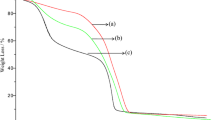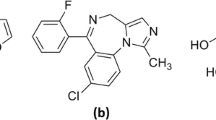Abstract
In this work, poly(methacrylic acid) (PMAA)-based molecularly imprinted polymer nanoparticles (MIP NPs) using isosorbide dinitrate (ISDN) as a template were prepared via a precipitation polymerization. The morphology and performance of the samples were investigated by varying different concentrations of azobisisobutyronitrile (AIBN) as an initiator. The MIP NP sample characterization as a function of the initiator concentration was evaluated utilizing Fourier transform infrared (FTIR) spectroscopy and field emission-scanning electron microscopy (FE-SEM) analyses. Regarding the washed MIP NP samples, the FTIR spectra results showed two main characteristic peaks located at 3339 and 1734 cm−1 wavenumbers corresponding to hydroxyl (–OH) and carbonyl (–C=O) groups, respectively. The intensity of these main peaks for the washed MIP NPs was higher than that of those for unwashed MIP NPs in which the active sites were appropriately formed between the polymer and template. These observations were occurred at the maximum amount of AIBN concentration (3 mmol). Moreover, the FE-SEM micrograph images exhibited an average diameter of approximately 40 nm for the MIP NP sample prepared with a low concentration of the initiator (0.5% of polymerizable double bonds). Furthermore, another two key factors for the MIP NPs such as binding capacity, and surface area using Barrett–Joyner–Halenda (BJH) method were studied to apply them for drug delivery systems potentially. On the other hand, the release of ISDN from MIP NP was considered through phosphate buffer saline (PBS, pH 7.4) at 37 °C for 5 days. The results showed higher ability of the sample compared with the non-imprinted polymer (NIP) ones to control the drug release, and kinetic trend of the drug absorption within the MIP NPs followed the pseudo-first model. Finally, the obtained outcomes showed that the low amounts of the initiator concentration have an indispensable role on the physicochemical properties of the synthesized MIP NPs.








Similar content being viewed by others
References
Abdollahi E, Khalafi-Nezhad A, Mohammadi A et al (2018) Synthesis of new molecularly imprinted polymer via reversible addition fragmentation transfer polymerization as a drug delivery system. Polym (UK) 143:245–257. https://doi.org/10.1016/j.polymer.2018.03.058
Aeinehvand R, Zahedi P, Kashani-Rahimi S et al (2017) Synthesis of poly(2-hydroxyethyl methacrylate)-based molecularly imprinted polymer nanoparticles containing timolol maleate: morphological, thermal, and drug release along with cell biocompatibility studies. Polym Adv Technol 28:828–841. https://doi.org/10.1002/pat.3986
Aldana AA, Barrios B, Strumia M et al (2016) Dendronization of chitosan films: surface characterization and biological activity. React Funct Polym 100:18–25. https://doi.org/10.1016/j.reactfunctpolym.2016.01.003
Anirudhan TS, Divya PL, Nima J (2013) Silylated montmorillonite based molecularly imprinted polymer for the selective binding and controlled release of thiamine hydrochloride. React Funct Polym 73:1144–1155. https://doi.org/10.1016/j.reactfunctpolym.2013.05.004
Ansell RJ (2015) Characterization of the binding properties of molecularly imprinted polymers. Adv Biochem Eng Biotechnol 150:51–93. https://doi.org/10.1007/10_2015_316
Ao J, Gu J, Yuan T et al (2018) Applying molecular modelling and experimental studies to develop molecularly imprinted polymer for domoic acid enrichment from both seawater and shellfish. Chemosphere 199:98–106. https://doi.org/10.1016/j.chemosphere.2018.02.005
Beyazit S, Tse B, Bui S et al (2016) Progress in polymer science molecularly imprinted polymer nanomaterials and nanocomposites by controlled/living radical polymerization. Prog Polym Sci 62:1–21. https://doi.org/10.1016/j.progpolymsci.2016.04.001
Clausen DN, Pires IMR, Tarley CRT (2014a) Improved selective cholesterol adsorption by molecularly imprinted poly(methacrylic acid)/silica (PMAA–SiO2) hybrid material synthesized with different molar ratios. Mater Sci Eng C 44:99–108. https://doi.org/10.1016/j.msec.2014.08.008
Clausen DN, Visentainer JV, Tarley CRT et al (2014b) Development of molecularly imprinted poly(methacrylic acid)/silica for clean-up and selective extraction of cholesterol in milk prior to analysis by HPLC-UV. Analyst 139:5021. https://doi.org/10.1039/C4AN00517A
Dabrowski M, Lach P, Cieplak M, Kutner W (2018) Nanostructured molecularly imprinted polymers for protein chemosensing. Biosens Bioelectron 102:17–26. https://doi.org/10.1016/j.bios.2017.10.045
De Oliveira FM, Segatelli MG, Tarley CRT (2016) Hybrid molecularly imprinted poly(methacrylic acid-TRIM)-silica chemically modified with (3-glycidyloxypropyl)trimethoxysilane for the extraction of folic acid in aqueous medium. Mater Sci Eng C 59:643–651. https://doi.org/10.1016/j.msec.2015.10.061
Dobrovolskaia MA, Patri AK, Zheng J et al (2009) Interaction of colloidal gold nanoparticles with human blood: effects on particle size and analysis of plasma protein binding profiles. Nanomed Nanotechnol Biol Med 5:106–117. https://doi.org/10.1016/j.nano.2008.08.001
Dos Santos Moretti E, de Oliveira FM, Scheel GL et al (2016) Synthesis of surface molecularly imprinted poly(methacrylic acid-hemin) on carbon nanotubes for the voltammetric simultaneous determination of antioxidants from lipid matrices and biodiesel. Electrochim Acta 212:322–332. https://doi.org/10.1016/j.electacta.2016.06.174
Erdőssy J, Horváth V, Yarman A et al (2016) Electrosynthesized molecularly imprinted polymers for protein recognition. TrAC Trends Anal Chem 79:179–190. https://doi.org/10.1016/j.trac.2015.12.018
Flavin K, Resmini M (2009) Imprinted nanomaterials: a new class of synthetic receptors. Anal Bioanal Chem 393:437–444. https://doi.org/10.1007/s00216-008-2496-8
Florea AM, Iordache TV, Branger C et al (2016) An innovative approach to prepare hypericin molecularly imprinted pearls using a “phyto-template”. Talanta 148:37–45. https://doi.org/10.1016/j.talanta.2015.10.061
Flores Ramos JM, Devoize L, Descheemaeker A et al (2017) The nitric oxide donor, isosorbide dinitrate, induces a cephalic cutaneous hypersensitivity, associated with sensitization of the medullary dorsal horn. Neuroscience 344:157–166. https://doi.org/10.1016/j.neuroscience.2016.12.028
Flower GL, Latha SV, Rao KV (2016) Novel characterization of nanosilver fluid through ultrasonic studies supported by UV–Vis spectroscopy, DLS and TEM studies. J Mol Liq 221:333–338. https://doi.org/10.1016/j.molliq.2016.06.017
Golker K, Nicholls IA (2016) The effect of crosslinking density on molecularly imprinted polymer morphology and recognition. Eur Polym J 75:423–430. https://doi.org/10.1016/j.eurpolymj.2016.01.008
Hashemi-Moghaddam H, Zavareh S, Karimpour S, Madanchi H (2017) Evaluation of molecularly imprinted polymer based on HER2 epitope for targeted drug delivery in ovarian cancer mouse model. React Funct Polym 121:82–90. https://doi.org/10.1016/J.REACTFUNCTPOLYM.2017.10.025
Hiratani H, Fujiwara A, Tamiya Y et al (2005) Ocular release of timolol from molecularly imprinted soft contact lenses. Biomaterials 26:1293–1298. https://doi.org/10.1016/j.biomaterials.2004.04.030
Jeon SJ, Jung MY, Do JY (2016) Anionic ring-opening polymerization of cyclic 1,3-dithiocarbonate and thermal depolymerization. React Funct Polym 100:37–43. https://doi.org/10.1016/j.reactfunctpolym.2016.01.005
Joshi S, Lehmler H-J, Knutson BL, Rankin SE (2017) Imprinting of Stöber particles for chirally-resolved adsorption of target monosaccharides and disaccharides. New J Chem 41:11525–11532. https://doi.org/10.1039/c7nj01938f
Kempe H, Parareda Pujolràs A, Kempe M (2015) Molecularly imprinted polymer nanocarriers for sustained release of erythromycin. Pharm Res 32:375–388. https://doi.org/10.1007/s11095-014-1468-2
Kurczewska J, Cegłowski M, Pecyna P et al (2017) Molecularly imprinted polymer as drug delivery carrier in alginate dressing. Mater Lett 201:46–49. https://doi.org/10.1016/J.MATLET.2017.05.008
Lanza F, Hall AJ, Sellergren B et al (2001) Development of a semiautomated procedure for the synthesis and evaluation of molecularly imprinted polymers applied to the search for functional monomers for phenytoin and nifedipine. Anal Chim Acta 435:91–106. https://doi.org/10.1016/S0003-2670(01)00905-9
Maheswari JU, Muthu S, Sundius T (2013) Spectrochimica acta part a: molecular and biomolecular spectroscopy an experimental and theoretical study of the vibrational spectra and structure of isosorbide dinitrate. Spectrochim Acta Part A Mol Biomol Spectrosc 109:322–330. https://doi.org/10.1016/j.saa.2013.03.031
Mao C, Xie X, Liu X et al (2017) The controlled drug release by pH-sensitive molecularly imprinted nanospheres for enhanced antibacterial activity. Mater Sci Eng, C 77:84–91. https://doi.org/10.1016/J.MSEC.2017.03.259
Marcelo G, Ferreira IC, Viveiros R, Casimiro T (2018) Development of itaconic acid-based molecular imprinted polymers using supercritical fluid technology for pH-triggered drug delivery. Int J Pharm 542:125–131. https://doi.org/10.1016/j.ijpharm.2018.03.010
Mattsson L, Xu J, Preininger C et al (2018) Competitive fluorescent pseudo-immunoassay exploiting molecularly imprinted polymers for the detection of biogenic amines in fish matrix. Talanta 181:190–196. https://doi.org/10.1016/j.talanta.2018.01.010
Mazzotta E, Turco A, Chianella I et al (2016) Solid-phase synthesis of electroactive nanoparticles of molecularly imprinted polymers. A novel platform for indirect electrochemical sensing applications. Sens Actuators B Chem 229:174–180. https://doi.org/10.1016/j.snb.2016.01.126
Meischl F, Schemeth D, Harder M et al (2016) Synthesis and evaluation of a novel molecularly imprinted polymer for the selective isolation of acetylsalicylic acid from aqueous solutions. J Environ Chem Eng 4:4083–4090. https://doi.org/10.1016/j.jece.2016.09.013
Mohebali A, Abdouss M, Mazinani S, Zahedi P (2016) Synthesis and characterization of poly(methacrylic acid)-based molecularly imprinted polymer nanoparticles for controlled release of trinitroglycerin. Polym Adv Technol 27:1164–1171. https://doi.org/10.1002/pat.3778
Nakamura Y, Matsunaga H, Haginaka J (2016) Preparation of molecularly imprinted polymers for strychnine by precipitation polymerization and multistep swelling and polymerization and their application for the selective extraction of strychnine from nux-vomica extract powder. J Sep Sci 39:1542–1550. https://doi.org/10.1002/jssc.201600027
Nakamura Y, Masumoto S, Matsunaga H, Haginaka J (2017) Molecularly imprinted polymer for glutathione by modified precipitation polymerization and its application to determination of glutathione in supplements. J Pharm Biomed Anal 144:230–235. https://doi.org/10.1016/j.jpba.2016.12.006
Neděla O, Slepička P, Kolská Z et al (2016) Functionalized polyethylene naphthalate for cytocompatibility improvement. React Funct Polym 100:44–52. https://doi.org/10.1016/j.reactfunctpolym.2016.01.004
Nestora S, Merlier F, Prost E et al (2016) Solid-phase extraction of betanin and isobetanin from beetroot extracts using a dipicolinic acid molecularly imprinted polymer. J Chromatogr A 1465:47–54. https://doi.org/10.1016/j.chroma.2016.08.069
Noee S, Salimraftar N, Abdouss M, Riazi G (2013) Imprinted microspheres and nanoparticles with diclofenac sodium: effect of solvent on the morphology and recognition properties. Polym Int 62:1711–1716. https://doi.org/10.1002/pi.4471
Orihara K, Hikichi A, Arita T et al (2018) Journal of Pharmaceutical and Biomedical Analysis Heparin molecularly imprinted polymer thin film on gold electrode by plasma-induced graft polymerization for label-free biosensor. J Pharm Biomed Anal 151:324–330. https://doi.org/10.1016/j.jpba.2018.01.012
Piletsky SA, Karim K, Piletska EV et al (2001) Recognition of ephedrine enantiomers by molecularly imprinted polymers designed using a computational approach. Analyst 126:1826–1830. https://doi.org/10.1039/b102426b
Rutkowska M, Płotka-Wasylka J, Morrison C et al (2018) Application of molecularly imprinted polymers in analytical chiral separations and analysis. TrAC Trends Anal Chem 102:91–102. https://doi.org/10.1016/j.trac.2018.01.011
Sellergren B, Allender CJ (2005) Molecularly imprinted polymers: a bridge to advanced drug delivery. Adv Drug Deliv Rev 57:1733–1741. https://doi.org/10.1016/j.addr.2005.07.010
Selvolini G, Marrazza G (2017) MIP-based sensors: promising new tools for cancer biomarker determination. Sensors 17:718. https://doi.org/10.3390/s17040718
Shi Y, Lv H, Lu X et al (2012) Uniform molecularly imprinted poly(methacrylic acid) nanospheres prepared by precipitation polymerization: the control of particle features suitable for sustained release of gatifloxacin. J Mater Chem 22:3889. https://doi.org/10.1039/c2jm15680f
Song R, Hu X, Guan P et al (2014) Molecularly imprinted solid-phase extraction of glutathione from urine samples. Mater Sci Eng C 44:69–75. https://doi.org/10.1016/j.msec.2014.08.005
Tarley CRT, Corazza MZ, Somera BF, Segatelli MG (2015) Preparation of new ion-selective cross-linked poly(vinylimidazole-co-ethylene glycol dimethacrylate) using a double-imprinting process for the preconcentration of Pb2+ ions. J Colloid Interface Sci 450:254–263. https://doi.org/10.1016/j.jcis.2015.02.074
Wang J, Cormack PAG, Sherrington DC, Khoshdel E (2007) Synthesis and characterization of micrometer-sized molecularly imprinted spherical polymer particulates prepared via precipitation polymerization. Pure Appl Chem 79:1505–1519. https://doi.org/10.1351/pac200779091505
Wang Y, Li Z, Shao P et al (2014) A novel multiple drug release system in vitro based on adjusting swelling core of emulsion electrospun nanofibers with core-sheath structure. Mater Sci Eng, C 44:109–116. https://doi.org/10.1016/j.msec.2014.08.015
Wang DD, Gao D, Xu WJ et al (2018) Magnetic molecularly imprinted polymer for the selective extraction of hesperetin from the dried pericarp of Citrus reticulata Blanco. Talanta 184:307–315. https://doi.org/10.1016/j.talanta.2018.03.010
Wen L, Tan X, Sun Q et al (2016) Smart molecularly imprinted monoliths for the selective capture and easy release of proteins. J Sep Sci 39:3267–3273. https://doi.org/10.1002/jssc.201600576
White CJ, Byrne ME (2010) Molecularly imprinted therapeutic contact lenses. Expert Opin Drug Deliv 7:765–780. https://doi.org/10.1517/17425241003770098
Wong A, De Oliveira FM, Tarley CRT, Del Pilar Taboada Sotomayor M (2016) Study on the cross-linked molecularly imprinted poly(methacrylic acid) and poly(acrylic acid) towards selective adsorption of diuron. React Funct Polym 100:26–36. https://doi.org/10.1016/j.reactfunctpolym.2016.01.006
Yang K, Wang GN, Liu HZ et al (2017) Preparation of dual-template molecularly imprinted polymer coated stir bar based on computational simulation for detection of fluoroquinolones in meat. J Chromatogr B 1046:65–72. https://doi.org/10.1016/j.jchromb.2017.01.033
Zahedi P, Rezaeian I, Ranaei-Siadat SO et al (2010) A review on wound dressings with an emphasis on electrospun nanofibrous polymeric bandages. Polym Adv Technol 21:77–95. https://doi.org/10.1002/pat.1625
Zahedi P, Fallah-Darrehchi M, Nadoushan SA et al (2017) Morphological, thermal and drug release studies of poly(methacrylic acid)-based molecularly imprinted polymer nanoparticles immobilized in electrospun poly(ε-caprolactone) nanofibers as dexamethasone delivery system. Korean J Chem Eng 34:2110–2118. https://doi.org/10.1007/s11814-017-0078-1
Zoller D, Lüttgenau J, Steffen S, Bollwein H (2016) The effect of isosorbide dinitrate on uterine and ovarian blood flow in cycling and early pregnant mares: a pilot study. Theriogenology 85:1562–1567. https://doi.org/10.1016/j.theriogenology.2016.01.009
Acknowledgements
Funding was provided by Amirkabir University of Technology.
Author information
Authors and Affiliations
Corresponding author
Ethics declarations
Conflict of interest
On behalf of all authors, the corresponding author states that there is no conflict of interest.
Rights and permissions
About this article
Cite this article
Mohebali, A., Abdouss, M. & Zahedi, P. Isosorbide dinitrate template-based molecularly imprinted poly(methacrylic acid) nanoparticles: effect of initiator concentration on morphology and physicochemical properties. Chem. Pap. 72, 3005–3016 (2018). https://doi.org/10.1007/s11696-018-0536-1
Received:
Accepted:
Published:
Issue Date:
DOI: https://doi.org/10.1007/s11696-018-0536-1




